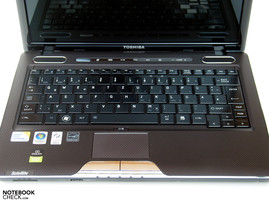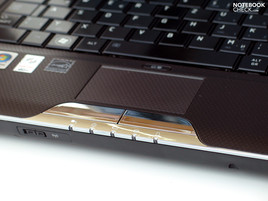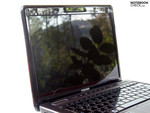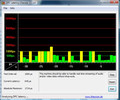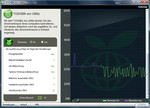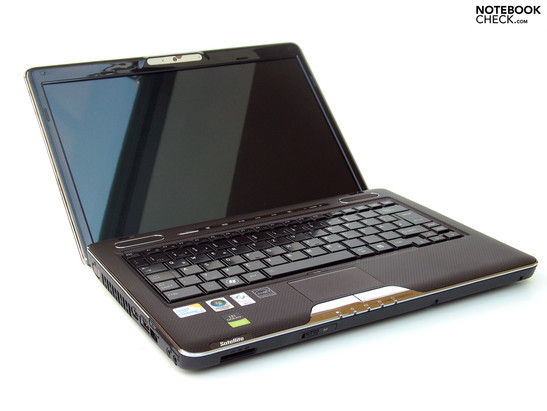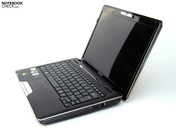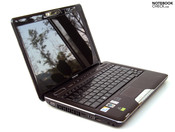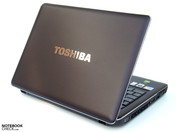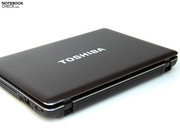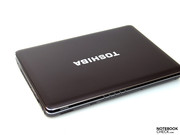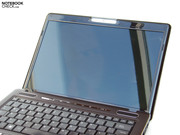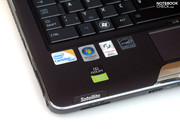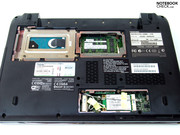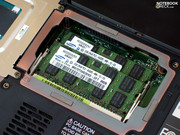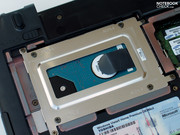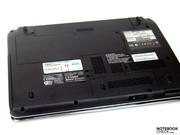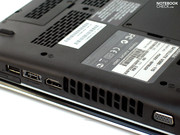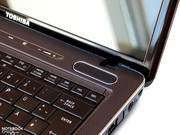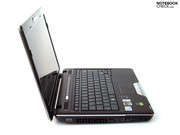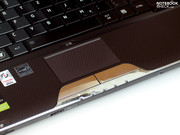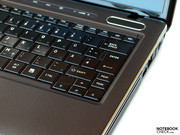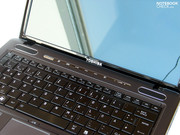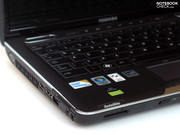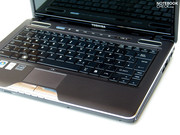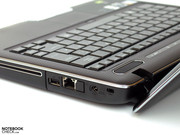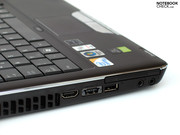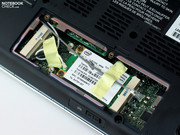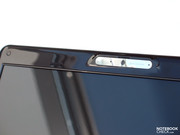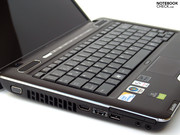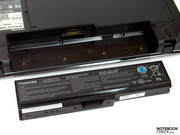Reviewed: Toshiba Satellite U500-115 Notebook
CULV? No thanks! Currently, an undaunted trend towards smaller notebooks can be observed. While the devices lose gram by gram, the performance, down to netbooks, constantly decreases as well - even though Nvidia steer in the opposite direction with their Ion platform. The U500 by Toshiba takes a further step here. Despite the compact 13.3" format, the laptop offers a powerful Intel Core 2 Duo CPU, and an independent middle-class graphics card by ATI.
At Toshiba, the label "Satellite" encompasses more or less the whole consumer product range. The Lxxx models are primarily placed at the lower end of the price range, followed by the Axxx allround models, and the Pxxx as those devices which distinguish themselves by a high performance. The Uxxx laptops are classified under the collective term "thin and light-weight". The Satellite U500-115 at hand, with a performant P8700 CPU and an ATI HD4570, shows that this does not necessarily mean waferthin CULV notebooks with limited performance. The Satellite U400 is a close relative, but it has to get along without dedicated graphics card, and also comes with decisively smaller processors.
Case
In the light of the current ultra-slim trend, the Toshiba U500's case almost appears massive and not particularly mobile. The look is not deceiving. Despite being small, the laptop weighs 2250 grams plus 460 grams for the power pack. And you really should not leave without the later as the battery life is rather short. We will cover this a little later.
Toshiba uses plastic in all forms and colors for the surfaces. Nevertheless, the U500 looks very attractive. The change between the different surfaces, simple plastic, relief-like structures, or also chrome and high-gloss elements, gives a successful layout.
Fortunately, the napped plastic is primarily found in the area of the palm rests. It does not only feel nice to the touch, but is also insusceptible to smudge. The same material is also used at the lid. Contrary to nowadays frequently used sensitive piano finish, which is very susceptible for traces of use, you need not be that careful when packing or unpacking the U500.
Another important element of design is the chrome molding around the case. Also the similarly shiny border around the loudspeakers is very eye-catching. On the one hand these accents look great. However, being part of the molding the touchpad buttons feature the same chrome finish, which is very susceptible to finger prints.
Not surprisingly the case offers very good stability. It is very torsion stiff and pressure resistant. The same is also true for the lid. Therefore, even picking the notebook up at an arbitrary corner is not a problem.
Although the hinges look big enough, they cannot quite convince in practice. It cannot completely prevent a luffing, which is especially annoying while working at the lap during, e.g., a train ride. In addition, we believe that their tractive power is too low for keeping the notebook securely closed without transport lock. So, you should take special care that dirt or even sharp objects cannot penetrate in between display and base unit if you transport this notebook. Using a separate protecting cover is recommendable.
Connectivity
Contrary to many other 13-inchers the Satellite U500 offers quite a big connectivity. The comparably thick base unit can use lots of ports. Without exception they are located at the notebook's sides. As long as one is content with the power supply, a USB port, and a connected ethernet cable, no complications around the notebook will arise. Right-handers will also appreciate that the optical drive is the front area of the right side.
If one albeit also uses the offered eSATA or the digital HDMI port, one has to take interferences by cables and plugs in the front area on the left side of the case into account. As a well shielded HDMI cable is not very flexible, the location of the HDMI port, which is often used instead of a VGA connection, is far from ideal.
We also missed the typical Toshiba-wheel for adjusting the volume of the speakers. The touch sensitive strip above the keyboard is unfortunately not in the same league.
A Gigabit Ethernet module by Realtek (RTL8168D/8111D) provides for fast data transfer via cable-bound networks. Fast wireless access is possible with the Intel WiFi Link 5100 WLAN-module (802.11a/g/draft-n). The notebook finally allows for smooth communication with a variety of external devices via Bluetooth.
An integrated "HD webcam" (maximum of 1280x800 pixels) is found in the display, we did albeit not further test its functionality. Windows Vista Home Premium serves as operating system. The huge number of pre-installed software includes useful applications, such as the Toshiba DVD player and also less relevant tools.
Toshiba extends 2 years of bring-in manufacturer's warranty for the Satellite U500. If one registers with the Toshiba notebook hotline, pick-up service is supposed to be available as well, Toshiba's website at least promises this.
Input Devices
Keyboard
The keyboard measures a total width of 27.5 centimeters, which is a bit less than units in larger 15" laptops. Nevertheless, touch typing was possible without any problems. A standard layout with all keys in there usual place is used.
However, the slick, lacquered surface of the keys does not feel nice to the touch. They feel sticky feeling especially if the fingers are not absolutely dry. Those who type a lot or fast, will likely appreciate the short travel and the flat key head. Even when typing rapidly, the tapping does not get too loud.
Still we found a single con: The keyboard gives and slightly springs during typing, but this is a matter of taste.
The hot keys shine very bright, possibly to bright in dim environments. Furthermore, the touch sensitive icons do respond surprisingly well, and enable e.g. controlling multimedia functions, or activating the eco-mode.
Touchpad
The touchpad is optically marked by a broad LED-bar, and can thus quickly be located in the dark as well. Altogether, the touch pad has to be described as rather small, but it does feature a very pleasing smooth surface. We also noticed that the factory settings are very sensitive. So, one has to get used to the rapid pointer first. Alternatively, one can of course adjust this to ones preferences.
Both touchpad buttons offer an agreeable point of pressure, and a very quiet clicking sound. Overall, Toshiba offers a thoroughly felicitous mobile mouse replacement.
Display
The display with a resolution of 1280x800 pixels in the 16:10 aspect ratio is almost to be called a rarity, since the majority of current notebooks uses the cinema-friendly 16:9 cinema format. The subjectively good brightness is also confirmed by our measurements. A maximum of 255 cd/m² is achieved in the central area, and it falls just below 200 cd/m² at corners. This gives a very good average brightness of 208 cd/m².
| |||||||||||||||||||||||||
Brightness Distribution: 74 %
Center on Battery: 255 cd/m²
Contrast: 123:1 (Black: 2.08 cd/m²)
Black looks rather bright, which is also proved by the measured black value of 2.08 cd/m². Of course the maximum contrast ratio this also results in a low contrast ratio of 123:1. Otherwise, the representation of colored pictures is acceptable.
The mediocre viewing angle stability is another disadvantage. The colors change comparatively quickly vertically, while a somewhat bigger deviation from the ideal viewing angle is possible horizontally. Also here, disruptive reflections will even arise indoors at adverse lighting conditions.
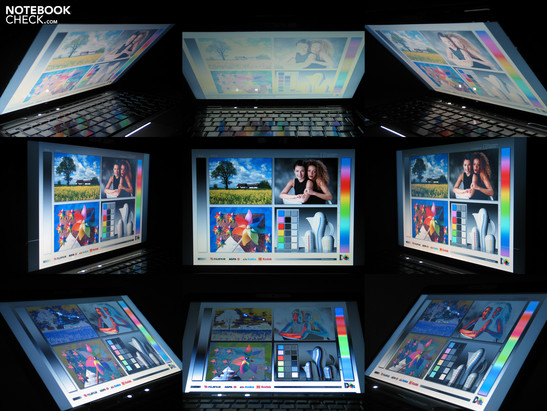
Performance
If your are looking for a compact notebook with good performance, you'll quickly realize reducing the size will also limit the performance of the built-in hardware. The Toshiba Satellite U500 takes a bit a special position here, since it features a powerful dual core CPU, the Intel Core 2 Duo P8700 CPU at 2.53 GHz, which clearly outperforms current CULV-processors.
But wait, there's more: Instead of the integrated graphic chip frequently used in notebooks of this size, the U500 is equipped with an ATI Mobility Radeon HD4570 with 512MB GDDR3 video memory. In our comparison of mobile graphics cards this ATI GPU is about on par with the Geforce 9500M by the competitor Nvidia, and, so, rather a low end class 2 graphics card. So, a good multimedia performance is given and current computer games can be played to some extent.
The reviewed Toshiba Satellite U500 reached 3703 points in the 3D Mark 2006 benchmark test, and is therewith on par with the Dell Studio 1555 (P8600/HD4570), the Lenovo Thinkpad T61p (T7500/FX570M), or also the Acer Aspire 6920G with Geforce 9500M GS graphics card.
| 3DMark 06 Standard Score | 3703 points | |
Help | ||
The result of PC Mark Vantage (3632 points), which among others evaluates the office performance is comparable. Because notebook known for their good performance achieve a similar score (Dell Studio XPS 16, HP Pavilion HDX 16, …), this can rightly be called good.
| PCMark Vantage Result | 3632 points | |
Help | ||
The Satellite appears to be very generous with a total of 4 Gigabyte RAM, but it cannot use the whole of the memory, since the 32-bit version of Windows Vista Home Premium was installed.
A hard disk of its own production with a gross capacity of 320 GB is used as mass storage device. It goes to work with 5400 rpm and achieves barely favorable results in the HDTune benchmark. Both the access time of 21.5 milliseconds as well as the average transfer rate of 30.9 MB/sec fall short of expectations. This might also be why the results of the PC Mark benchmark are only mediocre.
The hard drive protection was also annoying in the beginning. It activated itself on the slightest tremor and called attention to itself via a pop-up window. Once you deactivated this window, the protection performs its task in secret. It can then protect from possible loss of data in the case of a jolt.
We finally also took a look at the latencies under Windows using the tool DPC Latency Checker. Excesses of up to 1000 microseconds and more very often occurred here. Although the visualized bars stayed in the yellow area, one cannot rule out problems with the synchronization of external hardware (e.g. an external sound card) anymore.
People interested in the Toshiba U500 will on the one hand be performance- and design-oriented, but will probably also be found in the audience prone to gaming. Generally, we should attest that the U500 is not a gaming machine, but it does allow for playing current games as well, at least on low details.
GRID
For instance, we took a look at the racing game Racedriver GRID. Fraps delivered an average frame rate of 77.7 fps (on a low resolution of 800x600 pixels and on the lowest possible details) in a test run for team Germany in the demo version. Thus, the capacity for increasing the graphic details should still remain.
A word and a blow: we increased the resolution to 1024x768 pixels, and set the details to "medium" (everything switched on, 0xAA). The consequently reached 35 fps still means an acceptable performance to get your money's worth in the game. We did albeit not have a chance on high details, where the game juddered unplayable.
FEAR2
The spine-chilling shooter ran as fluently with an average of 124.8 fps on minimal details and a resolution of 800x600 pixels. Increasing the detail level to "medium" (2xAA, 1024x768) still produced downright playable 43.6 fps, tested during playing the demo version.
The Toshiba Satellite U500 does offer sufficient performance capacities for mastering the one or other game as well, as already presumed at the beginning. Even moderate adjustments concerning the display are possible.
Emissions
System Noise
The system fan is consistently active, both in idle mode and under a low office load. It is well audible (subjectively), and is potentially (in a particularly quiet surroundings) already to be described as disturbing. The measurement of the noise level at 37.8 dB (A) is also unambiguous in this regard.
If the notebook is put under full load (GPU and CPU), the device quickly becomes profoundly louder, and even reaches a maximum of 46.6 dB (A). The fan albeit stays somewhat below the maximum under "normal gaming load", at 39.5 dB (A). This can be described as downright acceptable.
Noise level
| Idle |
| 33.8 / 37.8 / 37.8 dB(A) |
| HDD |
| 34.2 dB(A) |
| DVD |
| 39.5 / dB(A) |
| Load |
| 39.5 / 46.6 dB(A) |
 | ||
30 dB silent 40 dB(A) audible 50 dB(A) loud |
||
min: | ||
Temperature
The notebook's heating surprisingly stays within narrow limits, both in idle mode and under load. After about an hour under full load for processor and graphics chip (prime95+Furmark), the case's top side reached a maximum of 38.2 °C. The bottom side reached 42.2 °C.
If one demands only a little from the notebook, it stays at a pleasant temperature and does not exceed the 34 °C mark at its top and bottom side.
(+) The maximum temperature on the upper side is 38.2 °C / 101 F, compared to the average of 36.9 °C / 98 F, ranging from 21.1 to 71 °C for the class Multimedia.
(±) The bottom heats up to a maximum of 42.2 °C / 108 F, compared to the average of 39.2 °C / 103 F
(+) In idle usage, the average temperature for the upper side is 31.3 °C / 88 F, compared to the device average of 31.3 °C / 88 F.
(±) The palmrests and touchpad can get very hot to the touch with a maximum of 36.2 °C / 97.2 F.
(-) The average temperature of the palmrest area of similar devices was 28.7 °C / 83.7 F (-7.5 °C / -13.5 F).
Loudspeakers
The two well-presented speakers on the left and right above the keyboard raise high expectations to the sound scape offered. And so does the "Dolby Sound Room" sticker. But disenchantment follows quickly as soon as one plays various songs. The maximum volume offered has to be described as only mediocre, and the thin and treble-heavy sound cannot really enthrall.
The loudspeakers' spatial effect is perceivable by all means, but this cannot really help get over the poor quality of sound.
Battery Life
Powerful components often demand a lot of energy and bring about a shorter battery life. Especially for very mobile notebooks, to which also the Toshiba U500 belongs, this is a big disadvantage. The integrated 40 Wh lithium-ion battery does raise hope here. The BatteryEater Reader's test, which represents the maximum battery life (minimum brightness, energy-saver profile, WLAN switched off) records only about 2.5 hours (163 minutes). The party was already over after 61 minutes under load (Battery Eaters Classic Test).
The practice-oriented usage with activated WLAN-module and maximum display brightness delivered a battery life of 124 minutes, about 2 hours. If you want to enjoy a movie from a DVD in battery operation, it should not take much longer than an hour, since the Satellite U500's battery is already drained after 80 minutes here.
Toshiba also integrates the Eco Utility into the Satellite U500. This software tool is supposed to help saving energy at the push of a button. The current consumption is at about 21-22W at balanced settings in idle mode (maximum brightness). This can be lowered a bit again with the Eco Utility, it then amounts to 14.5W. The laptop's reserve capacity becomes visible under load: peak values of up to 67W are within the realms of possibility by all means.
| Off / Standby | |
| Idle | |
| Load |
|
Key:
min: | |
Verdict
The Toshiba Satellite U500-115 presents itself as acutely attractive, although the case comes off comparatively weighty. Moreover, the device, which weighs 2.3 kilograms plus about half an kilogram for the power pack, does not really belong to the fly weights in 13 inch. However, you'll get reward with a robust case, which does, even under pressure, not betray weak spots, even not under pressure.
The connectivity is on par with well-equipped 15" multimedia notebooks. However, depending on the occupancy the arrangement of the ports might not be ideal.
The notebook offers a lavish keyboard as far as the input devices are concerned, which could by all means be interesting for those typing a lot, due to the short key travel. However, the lacquered surface, as well as the observed springing takes some getting used to though.
Toshiba fields a 16:10 display with a resolution of 1280x800. The brightness is downright good, but the glossy surface is responsible for annoying reflections. The stability of the angle of viewing could also be better, especially for a mobile 13" device.
As expected, the laptop's performance comes off good. The ever present fan for instance is a price of the good performance. It does its work well-audible even without work load. In contrary, the temperature always within a well-acceptable range.
The sound scape of the speakers is hardly attractive and their maximum volume seems to be too low for replaying music at room sound volume.
In favor of performance you also have to accept a rather low battery life. If you fancy the Toshiba U500, you should be satisfied with about two hours of WLAN surfing on battery. The Dell Studio XPS 13 with Nvidia 9500M graphics card, which is about on par in terms of price and performance, can be considered as equally powerful alternative.









